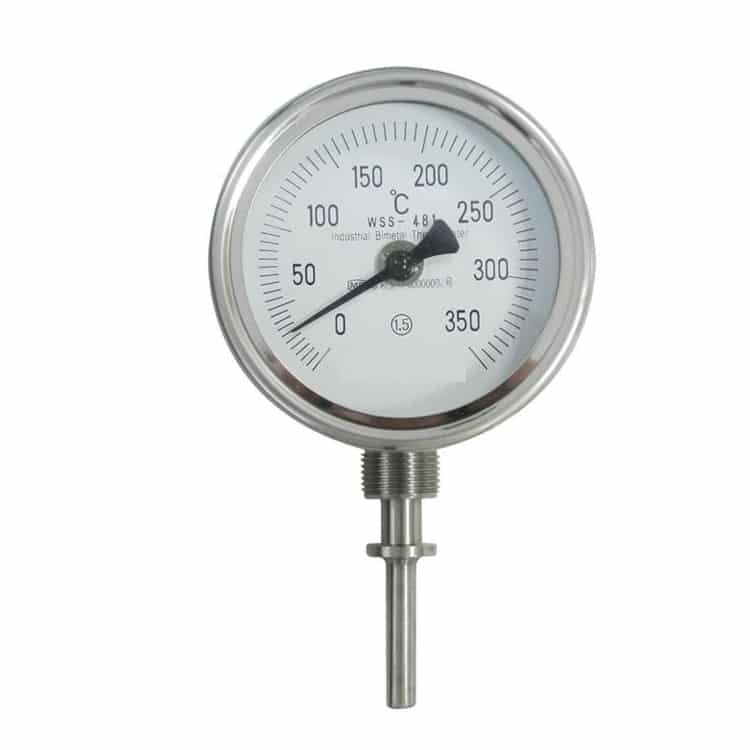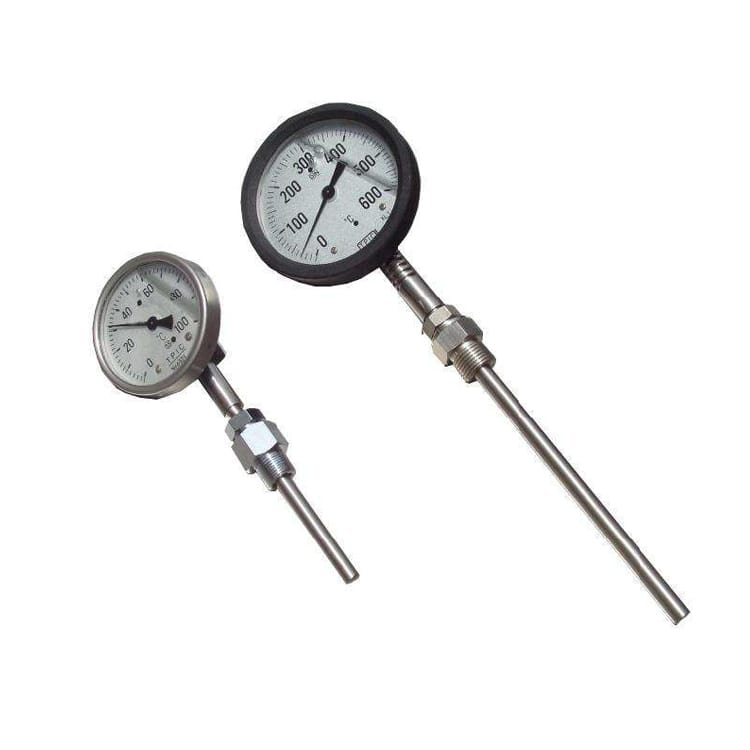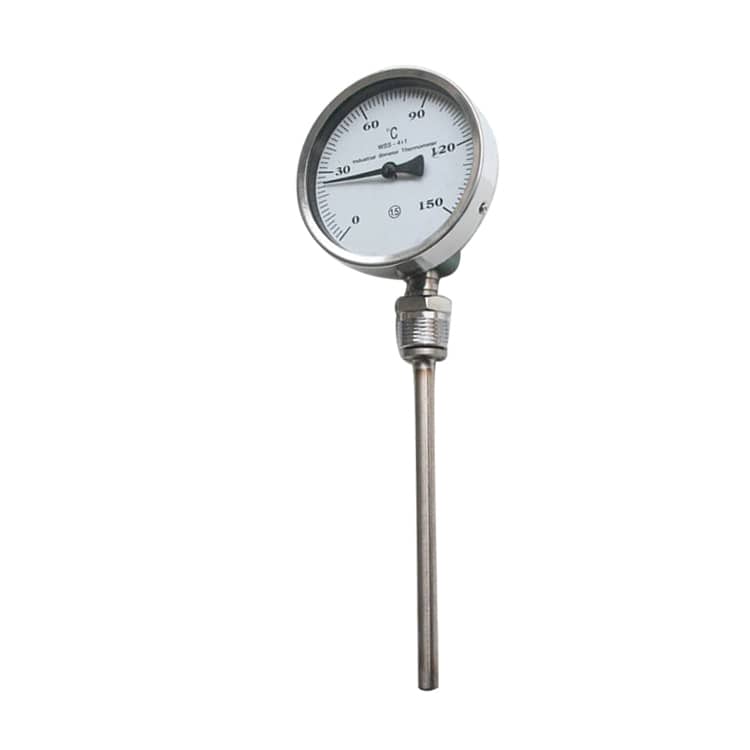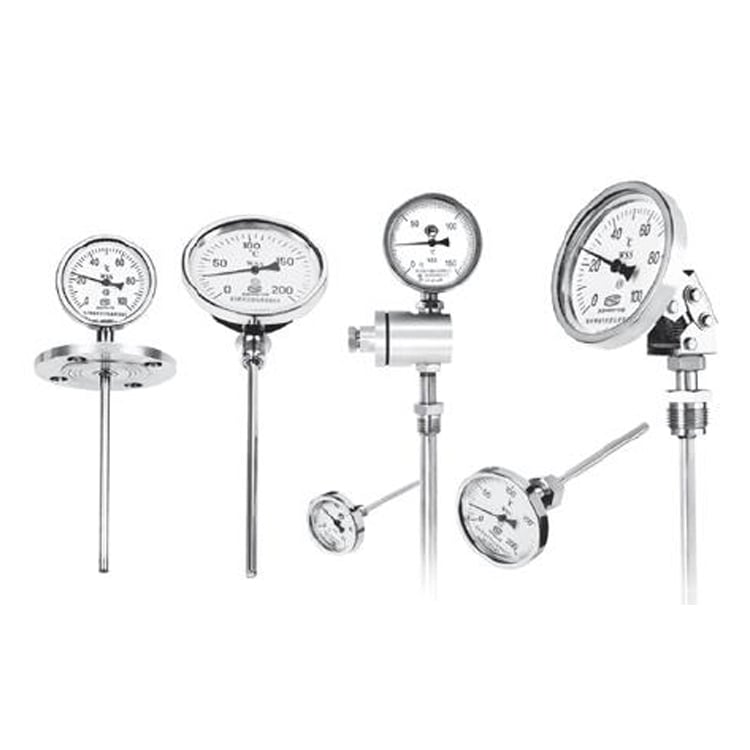What is a bimetallic stemmed thermometer?
Bimetallic stemmed thermometer is an instrument that uses two different metals to measure temperature. Two metals with different coefficients of linear expansion are combined and fixed at one end. When the temperature changes, the two metals have different degrees of thermal expansion. A pointer is driven to deflect to indicate the temperature. This is the bimetal thermometer. Usually, the layer of the bimetal with a small coefficient of expansion is called the passive layer, and the layer with a large coefficient of expansion is called the active layer. It can directly measure the temperature of liquid, steam and gas media in the range of -80℃~+500℃ in various production processes.
Benefits of bimetallic stemmed thermometer
- The thermal potential is not interfered with. The thermal potential of the bimetal stemmed thermometer is not disturbed by other factors. It is highly adaptable to different measurement environments.
- Diverse structure, can meet different measurement requirements. Can be used as electric contact bimetal thermometer, explosion-proof electric contact bimetal thermometer, remote transmission bimetal thermometer, etc.
- Fast temperature response and high sensitivity. At the same time, the temperature change is intuitive and can be displayed and recorded on site.
- Small size, easy to apply, and strong reliability of temperature measurement. Dial nominal diameter: 60,100 (4 inches), 150 optional.
- Long service life, can be used for long-term temperature detection in chemical production, stable physical and chemical properties.
- Stable anti-corrosion performance. Bimetal thermometers in chemical production often need to be used in liquid and gas environments. Has good corrosion resistance to protect the pipeline. Will not be affected by the measurement conditions and will not produce corrosion problems that affect the quality of measurement.
- High pressure-bearing capacity. Has good pressure-bearing capacity, can be measured under different pressure levels, and is highly adaptable to the measurement conditions.
- High electrical conductivity. Small resistance temperature coefficient, linear relationship between thermal potential and temperature, good linearity.
What is the most accurate way to calibrate a bimetal thermometer?
Method 1: Ice and water
- Fill a container with ice cubes, then add cold distilled water and let it sit for 4 to 5 minutes to form a watery slurry.
- Insert the thermometer probe into the container, making sure not to touch the side, and let it sit until the dial stops moving.
- If the thermometer is accurate, the temperature should be 32°F (0°C) after 30 seconds. If not, recalibrate the thermometer. Record discrepancies and offset thermometers as needed.
Method 2: Boiling Water
- Bring a clean container of distilled water to a boil.
- Once the water is boiling, insert the thermometer probe. Again, make sure the probe does not touch the sides or bottom of the pot. 3.
- The temperature should be 212°F (100°C). Record the difference and offset the thermometer as needed. Please note that the boiling point of water varies with altitude. Use this handy water boiling point calculator to find the right temperature for your altitude.
Bimetallic stem thermometer applications
- The bimetal thermometer is a field testing instrument used to measure low and medium temperatures. It can directly measure the temperature of liquid, steam and gas media in the range of -80℃~500℃ in various production processes.
- Electric contact bimetal thermometer is used for temperature control and alarm at production sites.
- Directly measure the temperature of liquid, steam and gaseous media in the range of -80℃~500℃ in various production processes.
- Explosion-proof bimetal thermometer can directly measure the presence of explosives such as hydrocarbons at the site. Directly measure the temperature of liquid, steam and gaseous media in the range of -80℃~500℃ in various production processes.
- Remote bimetal thermometer can directly read the site temperature. And the temperature signal can be transmitted to the remote control system.
Temperature range of a bimetallic stemmed thermometer
| Temperature range | Accuracy class | Graduation value ℃ | Minimum insertion depth Lmin (mm) | ||
| -40℃~80℃ | 1.5 | 2 | 45 | 55 | 60 |
| 0℃~50℃ | 1.5 | 1 | 110 | 130 | 140 |
| 0℃~100℃ | 1.5 | 2 | 55 | 65 | 70 |
| 0℃~150℃ | 1.5 | 2 | 40 | 45 | 50 |
| 0℃~200℃ | 1.5 | 5 | 30 | 35 | 40 |
| 0℃~300℃ | 1.5 | 5 | 50 | 60 | 60 |
| 0℃~400℃ | 1.5 | 10 | 40 | 50 | 50 |
| 0℃~500℃ | 1.5 | 10 | 35 | 40 | 40 |
| 0℃~600℃ | 1.5 | 10 | 30 | 35 | 35 |
| customizable | 1 | * | * | * | * |




